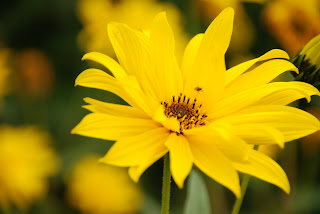Look At All The Pretty Colours
Having decided that black and white pictures with colour accents wouldn't cut the mustard, I started looking round for further inspiration. It wasn't hard to find, and it came in two forms: John Rankin Waddell, better known as Rankin, and as already stated, Edward Steichen. Both have an amazing ability to make a feature of colour. That's exactly what I want to do. Don't misunderstand me, I'm not talking about making a colour picture, but making a picture of colour (does that make sense?) What I mean is, I want the colour to be as integral a part of the picture as the subject posing. I'm not sure if that's the right attitude to have when doing a specialist certificate in people, but there you go.
Photograph by Rankin
Take for example the picture above. Without Rankin's liberal use of pigment, it would just be a standard picture, well composed and exposed, but a standard picture none the less. It's the strong contrast between the models pale skin, and the vivid colour, that really makes the picture stand out. The effect is further heightened, by the use of a plain white background and a strong light source.
Clearly I can't go around throwing art supplies in people faces (they tend to be funny about that sort of thing), I can however, use assorted other methods to add a sense of vibrancy to my pictures.
Clearly I can't go around throwing art supplies in people faces (they tend to be funny about that sort of thing), I can however, use assorted other methods to add a sense of vibrancy to my pictures.
Backgrounds
It goes without saying (but I'm going to say it anyway), that choosing the right background, is one of the most important aspects of producing a well composed photo. Although the college studio has a selection of background boards I could use, I'm probably going to bring in my own. I've been looking around, and have found a number of different fabrics that I think would work well as backdrops. I haven't decided yet whether I'll use a single block of strong colour, or try a patterned/striped background.
Photograph By Rankin
I'm going to be producing a mixture of different photographs: head shots, partial body shots, full body shots. That means I'm going to need a wide selection of material sizes. I think a 1x1 metre section should be fine for the head shots, but for the rest, I'm going to have to consult Marie.
As I explained with the first picture, a simple white background can also work well, but it does mean you're relying on the subject, or props, to add the impact to the photo. In order to achieve a pure white background, you have to correctly use my next subject: lighting.
Lighting
With the coloured background pictures, I'm going to try a couple of different lighting options, then see which I prefer. I'll try a high key look with some of them, but for others I'm going to try to add a little variety. I've seen a look in a few photos which I'd like to replicate. It involves allowing the colour to gradually darken as it reaches the edge of the frame, giving the subject a sort of halo.
I'm not sure yet if I'll try to achieve this practically or not. I could probably create the look fairly easily in the studio. I'd just have to use a snoot as the light source for the background, rather than the usual softboxes. If I decide to create the look in post processing, I'll just add a vignette in photoshop. Oh well, another question for Marie.
Props
I can't really go in to too much detail about which props I'm going to use, because I'm still trying to finalise my plans. In most of the pictures, any use of props will be minimal, but I've got one idea that calls for a number of different pieces. I'll try to explain more in a future post.
There you go. Under a thousand words.




























.jpg)
